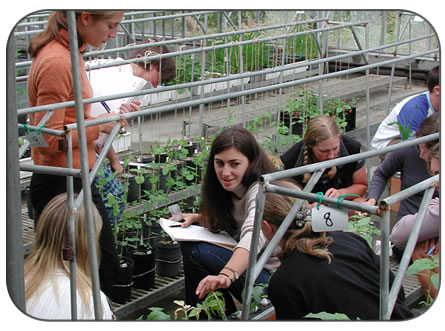 Laura Quittenden,
Laura Quittenden,
School of Plant Science, UTAS
Plants Have Hormones Too!
Ever wondered how plants grow? How some are tall, and others short, why roots grow down, and shoots grow up? It’s all about plant hormones – chemicals in plants that make things happen. Just like animals have hormones, like those that make us male or female, plants have hormones too!
Unlike many other scientists, I did not have an interest in science from a young age: I guess I didn’t really understand what it was all about. It wasn’t until I was in college, and took a Biology course that my interest was sparked, and I started to view the world in a different, scientific, way. Even then, I had no idea the impact that science would have on my life.
I went to UTAS to study a course in English or Psychology, and ended up following an entirely different path - to Life Sciences ie. plants and animals. I completed uni with a double-major Bachelor of Science degree in Plant Science and Zoology, and Honours in Plant Science. It just goes to show that you really don’t need to know exactly what you are going to do at Uni - you can just follow the paths that are open to you, those things that you enjoy. You never know where you’ll end up, but it will be a place that you want to be, and you’ll have enjoyed getting there!
So here I am, studying for my PhD in Plant Science, and focussing on hormone biosynthesis. My plan from here is to either teach science, or go into science communication within the community – I want to get across to people how important science is in the day-to-day lives of the public.
The great thing about a career in science is the scope for innovation and novelty that you gain with it – you can study anything you can dream up, and make your own break-throughs that can change how people see things forever: your imagination is the key to discovery.
Read More about Laura's research I am working on a project to find out how auxin is made in pea plants. Auxin is the main plant growth hormone, responsible for actions such as plant growth towards light sources (phototropism), and roots growing downwards (gravitropism). If I can unlock the key elements in the pathway to auxin in the plant, the understanding of how to make them grow will be greatly improved! If you can manipulate the amount of growth hormone in a plant, you can virtually manipulate its growth patterns and size. And hopefully stop the use of nasty pesticides and herbicides, which toxify our environment.
Find out more about research and careers in Plant Science at www.utas.edu.au/plantsci Or take a virtual look at the School of Plant Science’s Controlled Environment Facility, consisting of glasshouses, growth cabinets and specialised environments –providing highly accurate control over environmental growth conditions such as light, temperature, C02 levels and humidity www.utas.edu.au/glasshouse/





